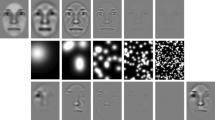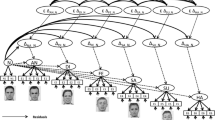Abstract
The present study tested whether neural sensitivity to salient emotional facial expressions was influenced by emotional expectations induced by a cue that validly predicted the expression of a subsequently presented target face. Event-related potentials (ERPs) elicited by fearful and neutral faces were recorded while participants performed a gender discrimination task under cued (‘expected’) and uncued (‘unexpected’) conditions. The behavioral results revealed that accuracy was lower for fearful compared with neutral faces in the unexpected condition, while accuracy was similar for fearful and neutral faces in the expected condition. ERP data revealed increased amplitudes in the P2 component and 200–250 ms interval for unexpected fearful versus neutral faces. By contrast, ERP responses were similar for fearful and neutral faces in the expected condition. These findings indicate that human neural sensitivity to fearful faces is modulated by emotional expectations. Although the neural system is sensitive to unpredictable emotionally salient stimuli, sensitivity to salient stimuli is reduced when these stimuli are predictable.
Similar content being viewed by others
References
Darwin C. The Expression of the Emotions in Man and Animal. New York: Oxford Press, 1998
Damasio A R. The Feeling of What Happens: Body and Emotion in the Making of Consciousness. New York: Harcout Brace Press, 1999
Yuan J J, Zhang Q L, Chen A T, et al. Are we sensitive to valence differences in emotionally negative stimuli? Electrophysiological evidence from an ERP study. Neuropsychologia, 2007, 45: 2764–2771 10.1016/j.neuropsychologia.2007.04.018, 17548095
Yuan J J, Yang J M, Meng X X, et al. The valence strength of negative stimuli modulates visual novelty processing: electrophysiological evidence from an event-related potential study. Neuroscience, 2008, 157:524–531 1:CAS:528:DC%2BD1cXhsVWlsrbP, 10.1016/j.neuroscience.2008.09.023, 18926886
Ito T A, Larsen J T, Smith N K, et al. Negative information weighs more heavily on the brain: The negativity bias in evaluative categorizations. J Pers Soci Psychol, 1998, 75:887–900 1:STN:280:DyaK1M%2Fkt12ltQ%3D%3D, 10.1037/0022-3514.75.4.887
Carreti’e L, Iglesias J, Garacia T, et al. N300, P300 and the emotional processing of visual stimuli. Electroencephalogr and Clin Neurophysiol, 1996, 103:298–303 10.1016/S0013-4694(96)96565-7
Carreti’e L, Mercado F, Tapia M, et al. Emotion, attention, and the ‘negativity bias’, studied through event-related potentials. Int J Psychophysiol, 2001, 41:75–85 10.1016/S0167-8760(00)00195-1
Campanella S, Gaspard C, Debatisse D, et al. Discrimination of emotional facial expressions in a visual oddball task: an ERP study. Biol psychol, 2002, 59:171–186 1:STN:280:DC%2BD383ntFSrtQ%3D%3D, 10.1016/S0301-0511(02)00005-4, 12009560
Campanella S, Rossignol M, Mejias S, et al. Human gender differences in an emotional visual oddball task: an event-related potentials study. Neurosci Lett, 2004, 367:14–18 1:CAS:528:DC%2BD2cXmsleltbs%3D, 10.1016/j.neulet.2004.05.097, 15308288
Yuan J J, Li H, Chen A T, et al. Neural correlates underlying humans’ differential sensitivity to emotionally negative stimuli of varying valences: an ERP study. Prog natural Sci, 2007, 17:115–121
Schupp H T, Öhman A, Junghöfer M, et al. The facilitated processing of threatening faces: an ERP analysis. Emotion, 2004, 4:189–200 10.1037/1528-3542.4.2.189, 15222855
Holroyd C B, Nieuwenhuis S, Yeung N, et al. Errors in reward prediction are reflected in the event-related brain potential. NeuroReport, 2003, 14:2481–2484 10.1097/00001756-200312190-00037, 14663214
Holroyd C B, Krigolson O E. Reward prediction error signals associated with a modified time estimation task. Psychophysiology, 2007, 44:913–917 10.1111/j.1469-8986.2007.00561.x, 17640267
Herwig U, Abler B, Walter H, et al. Expecting unpleasant stimuli-An fMRI study. Psychiat Res: NeuroImaging, 2007, 154:1–12 10.1016/j.pscychresns.2006.02.007
Onoda K, Okamoto Y, Shishida K, et al. Anticipation of affective image modulates visual evoked magnetic fields (VEF). Exp Brain Res, 2006, 175:536–543 10.1007/s00221-006-0569-5, 16847612
Ploghaus A, Tracey I, Gati J S, et al. Dissociating pain from its anticipation in the human brain. Science, 1999, 284:1979–1981 1:CAS:528:DyaK1MXktVWnsbo%3D, 10.1126/science.284.5422.1979, 10373114
Hall J A. Gender effects in decoding nonverbal cues. Psychol Bull, 1978, 85:845–857 10.1037/0033-2909.85.4.845
Li H, Yuan J J, Lin C D. The neural mechanism underlying the female advantage in identifying negative emotions: an event-related potential study. NeuroImage, 2008, 40:1921–1929 10.1016/j.neuroimage.2008.01.033, 18343686
Eimer M, Holmes A. Event-related brain potential correlates of emotional face processing. Neuropsychologia, 2007, 45:15–31 10.1016/j.neuropsychologia.2006.04.022, 16797614
Ekman P, Friesen W V, Ellsworth P. Emotion in the Human Face. New York: Pergamon Press, 1972
LeDoux J E. Emotion circuits in the brain. Annu Rev Neurosci, 2000, 23:155–184 1:CAS:528:DC%2BD3cXjs1Gmsr4%3D, 10.1146/annurev.neuro.23.1.155, 10845062
Öhman A. Face the beast and fear the face: animal and social fears as prototypes for evolutionary analyses of emotion. Psychophysiology, 1986, 23:123–145 10.1111/j.1469-8986.1986.tb00608.x, 3704069
Morris J S, Frith C D, Perrett D I, et al. A differential neural response in the human amygdala to fearful and happy facial expressions. Nature, 1996, 383:815–816 10.1038/383815a0
Anderson A K, Christoff K, Panitz D, et al. Neural correlates of the automatic processing of threat facial signals. J Neurosci, 2003, 23:5627–5633 1:CAS:528:DC%2BD3sXltl2qsLc%3D, 12843265
Smith N K, Cacioppo J T, Larsen J T, et al. May I have your attention please: electrocortical responses to positive and negative stimuli. Neuropsychologia, 2003, 41:171–183 10.1016/S0028-3932(02)00147-1, 12459215
Leppänen J M, Hietanen J K, Koskinen K. Differential early ERPs to fearful versus neutral facial expressions: a response to the salience of the eyes? Biol psychol, 2008, 78:150–158 10.1016/j.biopsycho.2008.02.002, 18359141
Batty M, Taylor M J. Early processing of six basic facial emotional expressions. Cognitive Brain Res, 2003, 17:613–620 10.1016/S0926-6410(03)00174-5
Pourtois G, Dan E S, Grandjean D, et al. Enhanced extrastriate visual response to bandpass spatial frequency filtered fearful faces: time course and topographic evoked-potentials mapping. Hum Brain Mapp, 2005, 26:65–79 10.1002/hbm.20130, 15954123
Stekelenburg J J, de Gelder B. The neural correlates of perceiving human bodies: an ERP study on the body-inversion effect. NeuroReport, 2004, 15:777–780 10.1097/00001756-200404090-00007, 15073513
Williams L M, Kemp A H, Felmingham K, et al. Neural biases to covert and overt signals of fear: dissociation by trait anxiety and depression. J Cognitive Neurosci, 2007, 19:1595–1608 10.1162/jocn.2007.19.10.1595
Delplanque S, Lavoie M E, Hot P, et al. Modulation of cognitive processing by emotional valence studied through event-related potentials in humans. Neurosci Lett, 2004, 356:1–4 1:CAS:528:DC%2BD2cXnvVWhtg%3D%3D, 10.1016/j.neulet.2003.10.014, 14746887
Delplanque S, Silvert L, Hot P, et al. Event-related P3a and P3b in response to unpredictable emotional stimuli. Biol Psychol, 2005, 68:107–120 10.1016/j.biopsycho.2004.04.006, 15450691
Huang Y X, Luo Y J. Temporal course of emotional negativity bias: an ERP study. Neurosci Lett, 2006, 398:91–96 1:CAS:528:DC%2BD28Xjs1ahtL4%3D, 10.1016/j.neulet.2005.12.074, 16446031
Abler B, Erk S, Herwig U, et al. Anticiptation of aversive stimuli activates extended amygdale in unipolar depression. J Psychiat Res, 2007, 1:511–522 10.1016/j.jpsychires.2006.07.020
Nitschke J B, Sarinopoulos I, Mackiewicz K L, et al. Functional neuroanatomy of aversion and its anticipation. NeuroImage, 2006, 29:106–116 10.1016/j.neuroimage.2005.06.068, 16181793
Bermpohl F, Pascual-Leone A, Amedi A, et al. Dissociable networks for the expectancy and perception of emotional stimuli in the human brain. Neuroimage, 2006, 30:588–600 10.1016/j.neuroimage.2005.09.040, 16275018
Perchet C, Revol O, Fourneret P, et al. Attention shifts and anticipatory mechanismsin hyperactive children: an ERP study using the posner paradigm. Society of Biological Psychiatry, 2001, 50:44–57 1:STN:280:DC%2BD3Mvgs1Sgug%3D%3D, 10.1016/S0006-3223(00)01119-7
Yuan J J, Luo Y J, Yan J H, et al. Neural correlates of the females’ susceptibility to negative emotions: an insight into gender-related prevalence of affective disturbances. Hum Brain Mapp, 2009, 30:3676–3686 10.1002/hbm.20796, 19404991
World Medical Organization. Declaration of Helsinki (1964). Br Med J, 1996, 313:1448–1449
Young A, Perrett D, Calder A, et al. Facial Expressions of Emotion: Stimuli and Tests (FEEST). Suffolk: Thames Valley Test Company, 2002
Bai L, Ma H, Huang Y X, et al. The development of native Chinese affective picture system—a pretest in 46 college students (in Chinese). Chin Men Heal J (in Chinese), 2005, 19:11
Joyce C, Rossion B. The face-sensitive N170 and VPP components manifest the same brain processes: the effect of reference electrode site. Clin Neurophysiol, 2005, 116:2613–2631 10.1016/j.clinph.2005.07.005, 16214404
Marzi T, Viggiano M P. Interplay between familiarity and orientation in face processing: an ERP study. Int J Psychophysiol, 2007, 65:182–192 10.1016/j.ijpsycho.2007.04.003, 17512996
Letourneau S M, Mitchell T V. Behavioral and ERP measures of holistic face processing in a composite task. Brain and Cognition, 2008, 67:234–245 10.1016/j.bandc.2008.01.007, 18336979
Williams L M, Palmer D, Liddell B J, et al. The “when” and “where” of perceiving signals of threat versus non-threat. NeuroImage, 2006, 31:458–467 10.1016/j.neuroimage.2005.12.009, 16460966
Leppänen J M, Moulson M C, Vogel-Farley V K, et al. An ERP study of emotional face processing in the adult and infant brain. Child Dev, 2007, 78:232–245 10.1111/j.1467-8624.2007.00994.x, 17328702
Porro C A, Cettolo V, Francescato M P, et al. Functional activity mapping of the mesial hemispheric wall during anticipation of pain. NeuroImage, 2003, 19:1738–1747 10.1016/S1053-8119(03)00184-8, 12948728
Chen A T, Xu P, Wang Q H, et al. The timing of cognitive control in partially incongruent categorization. Hum Brain Mapp, 2008, 29:1028–1039 10.1002/hbm.20449, 17894393
Goldstein A K, Spencer M, Donchin E. The influence of stimulus deviance and novelty on the P300 and Novelty P3. Psychophysiology, 2002, 39:781–790 10.1017/S004857720201048X, 12462506
Author information
Authors and Affiliations
Corresponding author
Additional information
Contributed equally to this work
Rights and permissions
About this article
Cite this article
Yang, J., Yuan, J. & Li, H. Emotional expectations influence neural sensitivity to fearful faces in humans: An event-related potential study. Sci. China Life Sci. 53, 1361–1368 (2010). https://doi.org/10.1007/s11427-010-4083-4
Received:
Accepted:
Published:
Issue Date:
DOI: https://doi.org/10.1007/s11427-010-4083-4




